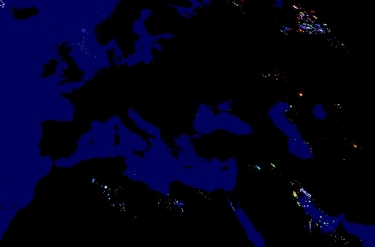I Spy With My Orbital Eye...
 One of my favorite early pieces for WorldChanging was the essay Greens In Space, arguing that space exploration, particularly robotic exploration, is ultimately in support of the Bright Green future. Of particular importance are the satellite systems used to observe changes on the Earth's surface. Two articles this past week nicely underscore that point.
One of my favorite early pieces for WorldChanging was the essay Greens In Space, arguing that space exploration, particularly robotic exploration, is ultimately in support of the Bright Green future. Of particular importance are the satellite systems used to observe changes on the Earth's surface. Two articles this past week nicely underscore that point.
The first (via James Hughes) comes from a report at the American Society of Tropical Medicine and Hygiene conference in Philadelphia: NASA satellites help health policy experts around the world watch for and respond to disease outbreaks, and can potentially help head off a pandemic.
The use of remote sensing technology aids specialists in predicting the outbreak of some of the most common and deadly infectious diseases today such as Ebola, West Nile virus and Rift Valley Fever. The ability of infectious diseases to thrive depends on changes in the Earth’s environment such as the climate, precipitation and vegetation of an area. [...] Remote sensing technology not only helps monitor infectious disease outbreaks in highly affected areas, but also provides information about possible plague-carrying vectors -- such as insects or rodents -- globally and within the U.S.
It's a simple story, but a useful reminder: we have the tools to fight these crises.
The second (via Ethan Zuckerman) is even more directly Bright Green: the use of satellite imagery to detect natural gas "flaring," in order to track its impact on the environment.
Natural gas often comes along with oil drilling, and -- amazingly -- some companies find it cheaper to burn off the gas onsite ("flaring") than to capture and sell it. This, in turn, appears connected to acid rain and lung disease, and simply dumps more carbon into the atmosphere without even generating useful work out of it. In 2002, Norway and the World Bank initiated the Global Gas Flaring Reduction partnership, trying to reduce the frequency of the practice. In order to enforce the agreement, and get a better handle on just how much gas flaring is underway, the GGFR brought in experts in satellite analysis to begin poring over data stretching back nearly 20 years.
The results found with this new tool are surprising. Conventional wisdom says that gas flaring is decreasing - the study found that it’s actually been pretty constant from 1995 to 2006. It’s been accepted that Nigeria is the biggest offender in gas flaring, conducting 20% of worldwide gas flaring. But the Nigerian government - in part driven by activism and violence in the Niger Delta, as well as concerns about health and environment - has been attempting to reduce gas flaring. [...]According to the analysis by NGDC, the real bad boys of gas flaring are the Russians, who flare twice as much gas as the Nigerians. Russia, unfortunately, is not a member of the Global Gas Flaring Reduction consortium - having data that shows that they’re the largest offender might help bring them within the fold.
Ethan's notes on the details of the gas flaring analysis are well-worth reading, and I encourage you to follow the link.
Back at WorldChanging, I used to post quite frequently about the variety of satellite-based projects underway to make information about the environment, human rights, agriculture, disease, etc. etc. more transparent and available. I haven't done that much over here at OtF -- in a way, the eyes in orbit have just been an assumed baseline. But with massive cuts to NASA's environmental satellites division, such an assumption is no longer warranted. We should take note of, and celebrate, the remaining satellite-based efforts while we can.






Comments
Interesting. So the mechanism that the disease-detection via satellite uses is a second order thing, watching for specific climate cues?
Posted by: Howard Berkey | November 14, 2007 11:39 AM